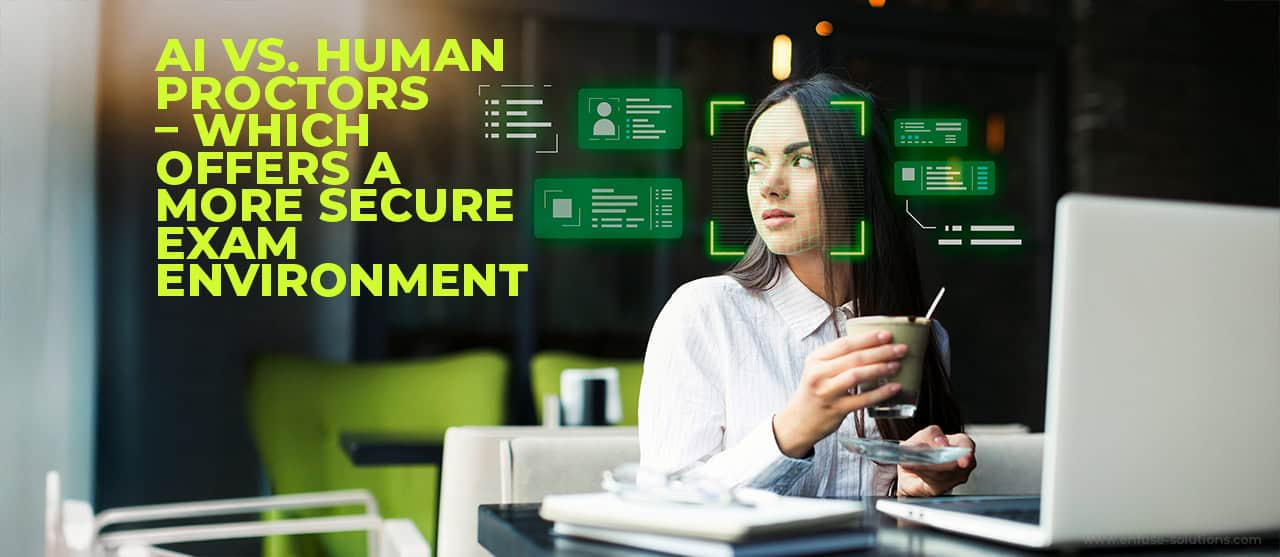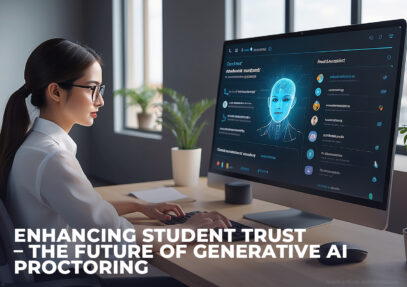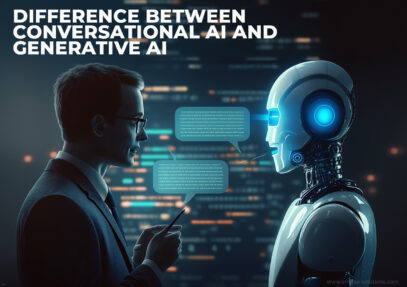
In the current digital era, the field of education is undergoing a significant transition. As online learning and remote assessments grow more common, maintaining the integrity and security of exams has become a major preference. This shift has sparked a debate: AI proctors versus human proctors— which provides a more secure exam environment?
This blog explores the capabilities of AI and human proctors, comparing their effectiveness in ensuring exam security.
The Rise Of AI Proctoring
Recently, the use of Artificial Intelligence (AI) for proctoring has grown immensely in popularity. Leveraging cutting-edge technologies, AI proctoring systems offer several features that enhance exam security. Some of the key features include:
1. Real-Time Monitoring: AI proctors use advanced algorithms to monitor students in real-time, detecting unusual behavior such as looking away from the screen or using unauthorized materials.
2. Facial Recognition: AI systems can identify and authenticate students through facial recognition technology, ensuring that the right individual is taking the exam.
3. Behavioral Analysis: AI can analyze students’ behavior patterns, flagging suspicious activities like multiple people in the room or unusual movements.
4. Automated Alerts: AI proctors can send instant alerts to human invigilators or administrators if any irregularities are detected, allowing for immediate intervention.
Human Proctoring: The Traditional Approach
In contrast, human proctoring has long been considered the benchmark for exam integrity. Human proctors bring a human touch to the exam process, offering several advantages:
1. Intuition And Experience: Human proctors can leverage their intuition and experience to detect subtle signs of cheating that AI might miss.
2. Immediate Intervention: Human proctors can immediately address any issues or concerns, providing a sense of security and reassurance to students.
3. Flexibility: Human proctors can adapt to unexpected situations, such as technical glitches or emergencies, ensuring the smooth conduct of exams.
Comparing Security Measures
When it comes to security, both AI and human proctors have their strengths and weaknesses.
AI Proctoring
1. Pros
- Scalability: AI proctors are capable of overseeing numerous students at once, which makes them particularly suited for large-scale examinations.
- Consistency: AI systems provide consistent monitoring, eliminating the potential for human error or bias.
- Cost-Effective: Over time, AI proctoring can be more cost-effective as it reduces the need for a large workforce.
2. Cons
- Limited Context Understanding: AI might struggle to understand the context behind certain behaviors, potentially flagging innocent actions as suspicious.
- Privacy Concerns: The use of facial recognition and continuous monitoring raises privacy concerns among students.
Human Proctoring
1. Pros
- Contextual Understanding: Human proctors are better equipped to grasp the context and subtleties of student behavior.
- Personal Interaction: Human proctors can provide reassurance and support, reducing exam anxiety.
- Ethical Considerations: Human proctors can ensure ethical considerations are met, respecting students’ privacy.
2. Cons
- Scalability Issues: Human proctors may find it challenging to monitor large numbers of students, especially in remote settings.
- Inconsistencies: Human error or bias can affect the consistency of monitoring.
Best Practices And Trends
To create a secure exam environment, combining the strengths of both AI and human proctors can be an effective strategy. Here are some recommended strategies and up-and-coming trends:
1. Hybrid Proctoring: Blending AI and human proctors provides the ideal combination of strengths from both approaches. AI handles real-time monitoring and flags potential issues, while human proctors provide oversight and context.
2. Data Analytics: Leveraging data analytics can help in identifying patterns and trends in cheating behaviour, enabling proactive measures to prevent academic dishonesty.
3. Continuous Improvement: Regularly updating AI algorithms and training human proctors on the latest techniques and tools can enhance the effectiveness of proctoring systems.
4. Student Education: Educating students about the importance of exam integrity and the consequences of cheating can foster a culture of honesty and accountability.
Future Of Proctoring
The future of exam proctoring relies on the seamless blend of AI and human factors. Innovations such as biometric authentication, blockchain technology for secure data storage, and enhanced AI algorithms will continue to evolve the landscape. Additionally, ensuring a balance between security and privacy will be paramount in gaining students’ trust and acceptance.
EnFuse Solutions: Your Trusted Proctoring Partner
At EnFuse Solutions, we recognize the challenges involved in establishing a secure exam setting. Our comprehensive proctoring services combine AI’s power and human proctors’ expertise to offer unparalleled security and integrity for your exams. With cutting-edge technology and a commitment to excellence, EnFuse Solutions is your trusted partner in delivering secure and reliable assessments.
Conclusion
The discussion surrounding AI versus human proctoring isn’t about selecting one option over the other but rather about achieving the optimal balance between them. Both approaches present distinct benefits and encounter their unique challenges. By embracing a hybrid approach, organizations can enhance exam security, improve candidate experience, and optimize costs. EnFuse Solutions is here to help you navigate this landscape, providing cutting-edge proctoring solutions tailored to your needs.

















Comment